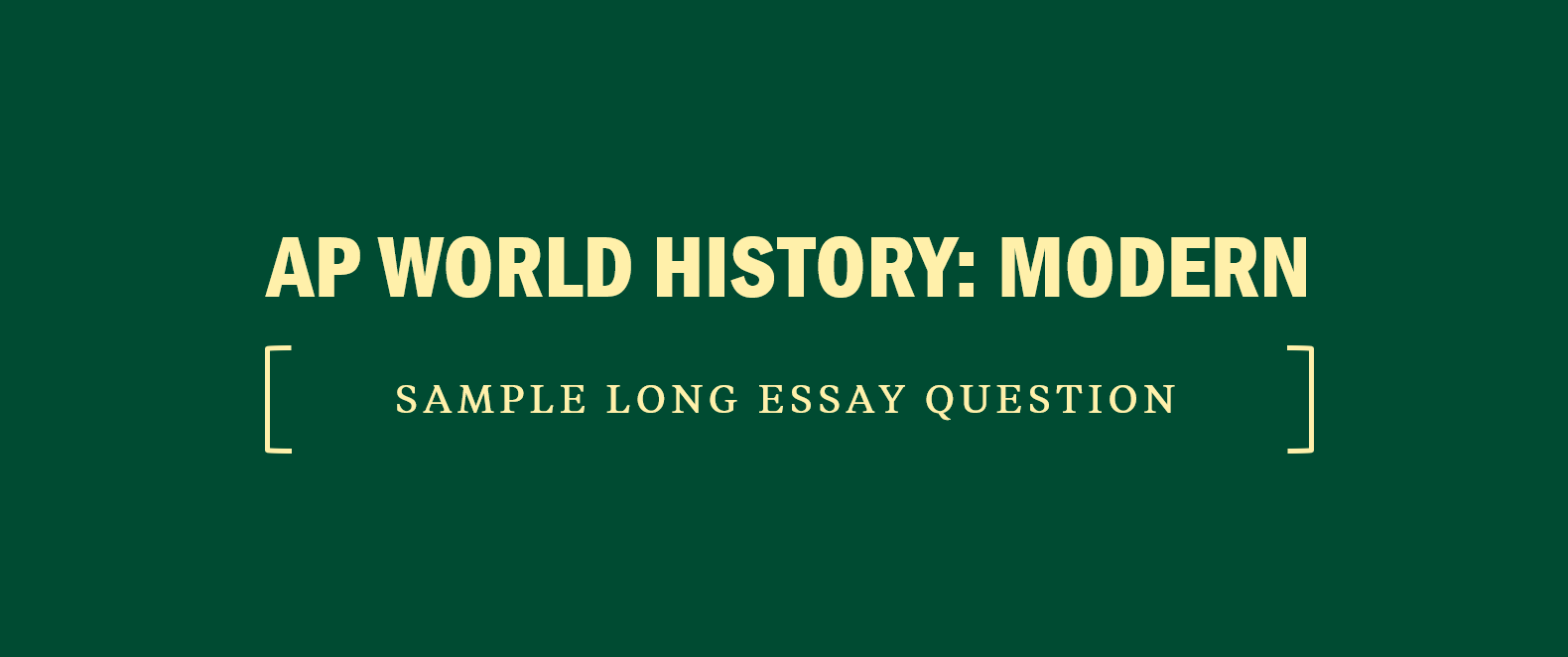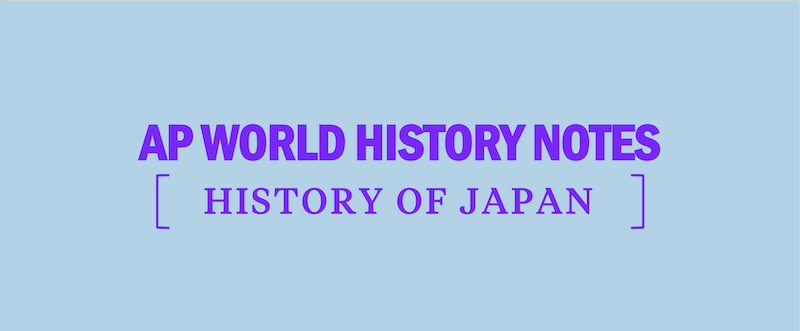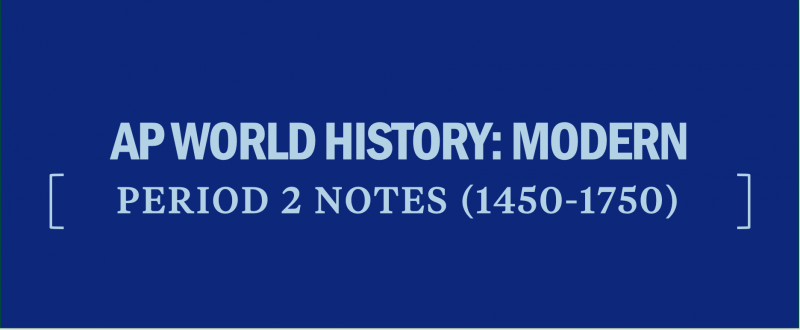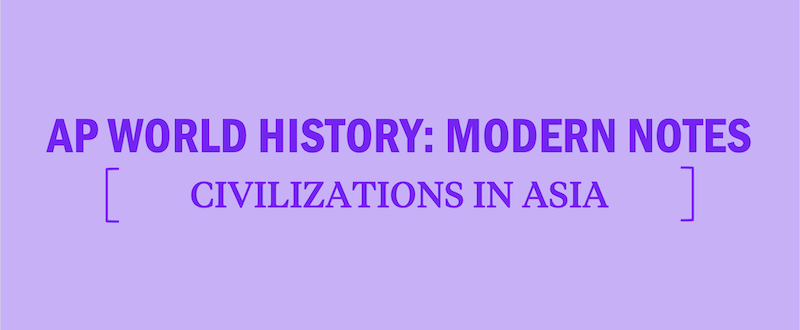AP World History: Modern Sample Long Essay Question
The AP World History: Modern Exam requires you to complete a long essay question. Read on for an example long essay question.
Step 1: Analyze the Prompt
On the actual exam, you will read three questions and determine which you can answer most confidently. For this sample question, note that you will be evaluating how changes in the spread of ideas impacted societies. The words “changes,” “impacted,” and “the extent” indicate that this prompt is testing the historical skill of continuity and change.
As you choose which question you will answer, begin thinking about what your thesis will entail and how your essay will demonstrate a complex understanding. The notes of a sample high- scoring writer are below. Note that the writer plans to develop a complex argument by addressing not only changes, as required by the prompt, but also continuities in societies before and after World War I.
Thesis: changes: faster spread of ideas made news, politics, and war more immersive and fast-paced; continuity: cross-cultural interactions transform all cultures (complex understanding, historical skill)
Step 2: Plan Your Response
Next, take time to plan your response. Check your plan against the long essay question require- ments. See the following sample plan that a high-scoring writer might make; scoring requirements are written in bold for reference.
- ¶ intro
- Context: Gutenberg → 2nd industrial revolution (steamship, train, telegraph) → digital revolution (radio, TV, Internet)
- Thesis: changes: faster spread of ideas made news, politics, and war more immersive and fast-paced; continuity: cross-cultural interactions transform all cultures (complex understanding, historical skill)
- Body ¶1: change: impact of news quicker and more significant
- Evidence: War of 1812 versus WWII, Vietnam, Gulf War
- Body ¶2: change: wars became more ideological, propaganda-based
- Evidence: American Revolution versus Cold War
- Body ¶3: continuity: interactions still change cultures, though intensified today
- Evidence: language: Arab traders & Swahili, and modern business & English
- ¶ conclusion: impacts of tech on society have become more pervasive, though tendency towards cross-cultural influence has persisted
Step 3: Action! Write Your Response & Step 4: Proofread
Use your plan to write each part of the response, and briskly skim for errors when finished.
See the following high-scoring response, and be sure to read the rubric to help you identify what makes this response effective. Think about what features you can incorporate into your own free- response answers.
Several landmark new technologies dramatically changed the speed of communication before and after the First World War. For most of history, faster communication was necessarily related to physical factors, such as a horse’s speed or the condition of trails between locations. Gutenberg’s printing press helped lower the cost of written material and thus democratized the spread of ideas beginning in the fifteenth century. By the nineteenth century, improvements to transportation technology during the second industrial revolution (the steamship and train) enabled ideas to spread across continents in days instead of weeks, and the telegraph made communication, at least that of short messages, nearly instantaneous. Remarkably, this process of change intensified after the communication and digital revolutions following WWI, as the radio and eventually television and the Internet brought instant news and ideas into nearly every home in industrialized nations. This accelerated pace of news has made societies more immersed in global politics and conflicts, while intensifying the historic tendency of cross-cultural interactions to transform societies.
A key change between these eras of communication is how the speed of ideas’ dissemination impacts their force of impact and makes news more pervasive in civilians’ lives. In the distant past, the slow rate of communication caused reactions that were often months, or even years, after the initial communication. For instance, the final battle of the War of 1812 was fought after the signing of the war’s peace treaty because news had not yet traveled by ship across the Atlantic Ocean. In contrast, the peace treaties of WWII were celebrated in cities around the world mere minutes after news of their signing was shared by telegram and radio signals. The quick spread of images and video from the Vietnam conflict helped intensify Americans’ resistance to the war. In recent decades, 24-hour live coverage of conflicts, as in CNN’s being the first to provide constant coverage of a war during the Gulf War, allowed policy- makers and civilians to respond instantly to developments. As news became quicker, so its impact became more significant and more immediate.
Another change is that the quick and pervasive spread of ideas has made political conflicts more ideological and propaganda-based, further drawing societies into global disputes. Political rebellions of the eighteenth century, such as the American and French Revolutions, were based on Enlightenment ideals such as equality and representative government; they made use of propaganda in the form of printed political cartoons, tracts, and engravings to spread their ideals among the populace. However, the news communication made possible by radio and television after World War II helped propel the ideological conflict between the communist Soviet Union and the democratic United States into a worldwide phenomenon that intensely impacted both nations’ citizens. Technology was able to so effectively spread this war of ideas that the two major superpowers never engaged in direct battle themselves; still, citizens were drawn into a culture of propaganda that demonized the other side, made bomb shelters and bomb drills a part of daily life due to fear of nuclear warfare, and saw governments pour millions of dollars into the space race. Technology thus made it possible for conflicts to become all-immersive, even if they were based on ideas rather than physical confrontations.
Despite changes in communication, constants about its impacts remain. Cross- cultural communications still transform societies as they borrow and adapt ideas from others. For instance, from the eighth century onward, Arab traders who traveled throughout West Africa and along the eastern and northern coasts not only enriched communities economically but also spread Islam. Further, the necessity for communication among traders led to the rise of Swahili, a language that combined Arabic and African words and is still the lingua franca in much of East Africa today. Similarly, in modern times, as Britain and then the United States dominated world trade, English became a kind of worldwide lingua franca of modern business. Just as Arab traders spread their religion, American culture also diffused to other societies: almost every nation in modern times, for instance, built American-style fast food restaurants. Mirroring the trends related to the spread of news and politics, cultural diffusions in recent decades occurred at a faster rate and to a more pervasive extent than in the past. Whereas primarily traders would have adopted Swahili as it developed over generations, today English is taught in grade schools throughout the world.
Cultures that interact always influence each other. In the past century, how- ideas travel at a faster pace. As they have in ever, technology has made the impact of this spread of ideas more pervasive and significant as news and political the past, societies will continue to transform as they encounter ideas from other cultures, but with this increased intensity of communication, the impacts of ideas will continue to escalate.
RELATED: How to Approach AP World History: Modern Short Answer Questions




